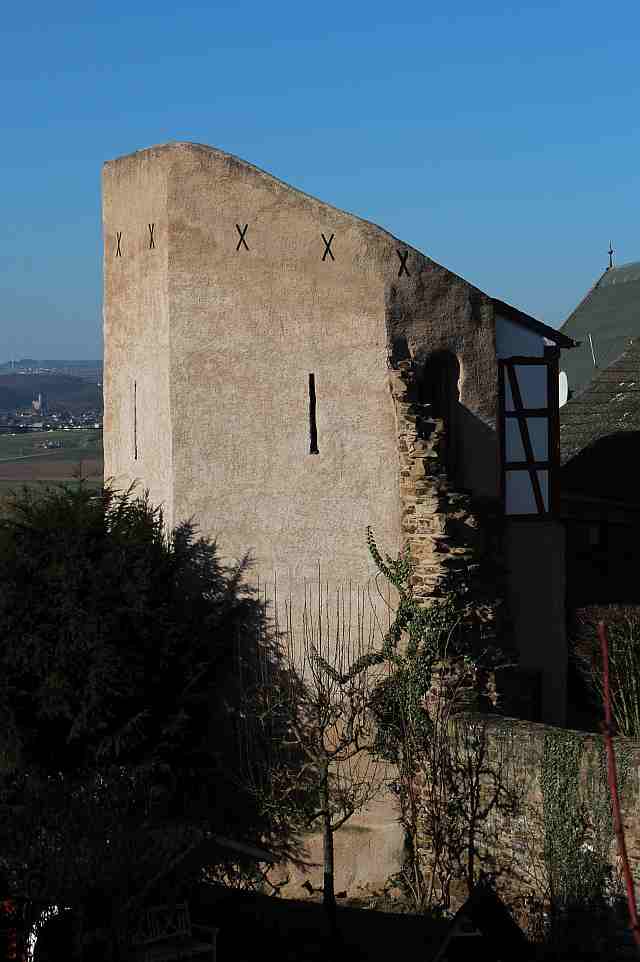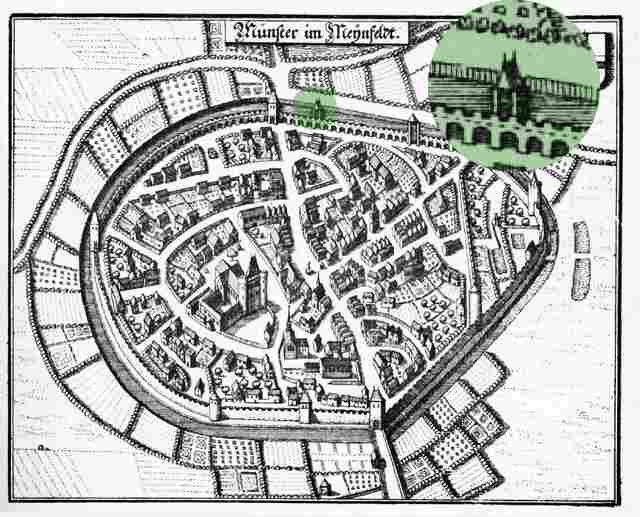12. Fortified Tower
Built in the 14th century
Münstermaifeld was surrounded by a town wall
with seven fortified towers. In 1822 the conversion
to a residential building preserved this tower.
It was reconstructed in 2008.
Erected in the 13th and 14th century, the city wall was fortified with seven towers. Apart from Lauffenburg, it is the only remaining fortified tower, and it thanks its survival its conversion to a residential house, which began in 1822. Originally, the half tower used to be 20 m high and was equipped with a cannon. The city wall’s maintenance cost the citizens a great deal of money and, with the progression of military techniques, it was increasingly considered a burden rather than a source of protection. Only with its removal since the end of the 18th century, has the city wall once again started to pay off as a stone quarry.
The tower, also called "Wahle Tower", was built in the 14th century.


It belonged to the 7 defence towers, was half hexagonal and 20 m high.
Franz Wahl converted the tower into a residential building in 1822 and thus saved a part of it. The city fortifications were brought up to the standard of 14th/15th century fortification architecture over a period of 100 years by the archbishops. The last extension was carried out in 1424 under Archbishop Otto von Ziegenhain, who exempted the town from all extraordinary taxes for 50 years. Despite the changes in military technology, especially the development of artillery, it was left at this level.

It is therefore not surprising that the military benefit of the city fortifications, which could only be maintained at great expense, was low. However, the city was not only responsible for the fortifications, it also had to prepare and organise the deployment of its citizens in the event of war.
Excerpts will be presented to show how this was regulated in the city ordinance of 1520: The case of war was declared by the Elector. The mayor led half of the citizens fit for military service into the field in harness on horseback. He carried the town banner and the staff of command with him. The army chests were carried on emergency carts. The contents of the boxes differed according to the rank of the soldiers.
The aldermen and the mayor, for example, had their own tent equipment and special provisions. The mayor had to appoint an alderman to represent him while he was marching out. The aldermen, burghers and clergymen who remained in the town had to stand guard and do everything they could to keep the town in safe order. After a fortnight, the half of the soldiers who remained in the town went into the field. The villages belonging to the district were also obliged to keep vigil in the sections of the town assigned to them.
A new slogan was issued every evening. If the march lasted longer and a guard had to be kept in the town, the clergymen could be replaced by two citizens each for a fee. Only captains who knew how to use the cannons were to command the city gates. Every citizen had to keep his place on the wall and was not allowed to move away. The mayor had to check the readiness of the citizens for war every year. Armour and weapons had to be kept ready.
With the restoration of the tower, the idea of the once walled city has become a little more vivid
Glossar



